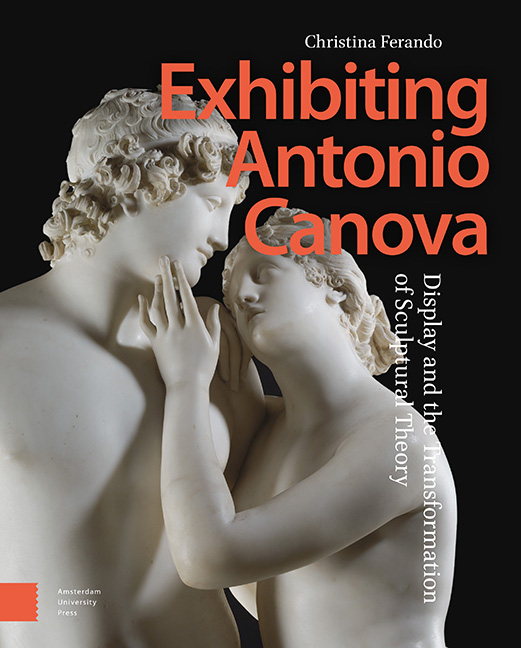Book contents
- Frontmatter
- Table of Contents
- List of Illustrations
- Acknowledgements
- Introduction: Canova on Display
- 1 Imagining Sculptural Practice
- 2 Reevaluating Ancients and Moderns
- 3 Anatomizing the Female Nude
- 4 Challenging the Supremacy of Painting
- 5 Defining Modern Sculpture
- Conclusion: Aftereffects
- Bibliography
- Index
Introduction: Canova on Display
Published online by Cambridge University Press: 13 February 2024
- Frontmatter
- Table of Contents
- List of Illustrations
- Acknowledgements
- Introduction: Canova on Display
- 1 Imagining Sculptural Practice
- 2 Reevaluating Ancients and Moderns
- 3 Anatomizing the Female Nude
- 4 Challenging the Supremacy of Painting
- 5 Defining Modern Sculpture
- Conclusion: Aftereffects
- Bibliography
- Index
Summary
Abstract: The introduction, “Canova on Display,” examines Canova’s dedication to the art of display and his innovative exhibition strategies. Beholders’ responses to these displays are firmly situated both in the Italian context that engendered him and in the international community that celebrated his work. The discourse generated by viewers in response to exhibitions of his works impacted the way works of arts were perceived, fueling reconsiderations of the sculptural medium and its place in cultural patrimony.
Keywords: sculpture installations, pedestals, lighting, grand tour, reception theory, art criticism
This is not a book about the making of art. Nor is it concerned with tracing the history of display or locating the origins of aesthetic theories. It is, rather, a consideration of the dynamic relationship between viewers and works of art. By using the work of Antonio Canova (1757–1822) as a linchpin, I explore the way viewing conditions, political turbulence, and familiarity with artistic concepts shaped beholders’ interpretations and judgments of objects. This, in turn, formed their understanding of themselves as beholders and critics. More importantly, however, their discussions shaped the legacy of important sculptural theories, helping usher in their modern definitions and creating the lenses through which we experience and interpret works of art. Beholders’ variable attitudes towards Canova’s work demarcate a transitional moment in the history of art and the establishment of modern attitudes not just towards sculpture, but towards cultural patrimony in general.
Canova’s career spanned the late eighteenth and early nineteenth centuries, a period when the European continent was experiencing considerable turmoil due to revolutionary forces in France and the subsequent establishment—and collapse—of the French empire. Despite the political upheaval within the Italian states and their occupation by foreign sovereigns, Canova was hailed as the greatest artist of the period (Fig. 0.1). His neoclassical creations exemplified the ideals of the ancients and merged a classical aesthetic with a Romantic sensibility, attracting admirers from across the globe. Moreover, upon the sculptures’ completion, Canova and his patrons took care to celebrate the masterful conception and carving of his works in the meticulous orchestration of their display.
- Type
- Chapter
- Information
- Exhibiting Antonio CanovaDisplay and the Transformation of Sculptural Theory, pp. 21 - 42Publisher: Amsterdam University PressPrint publication year: 2023



